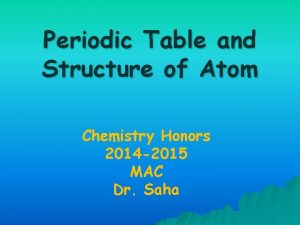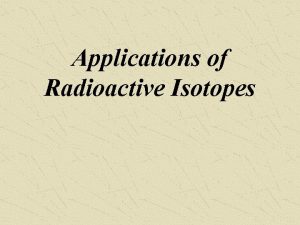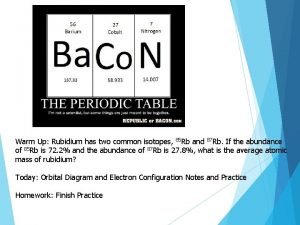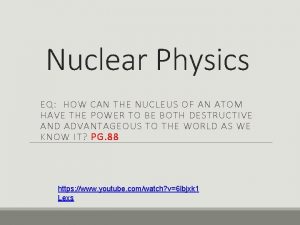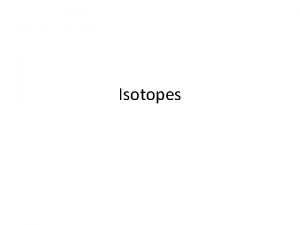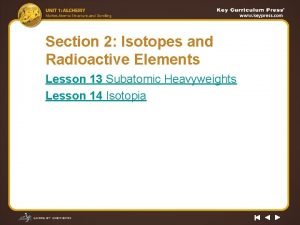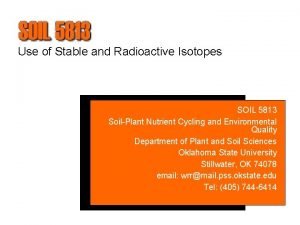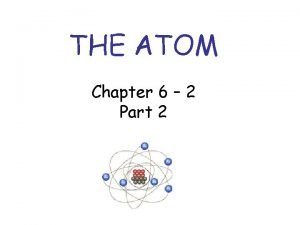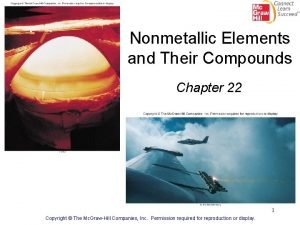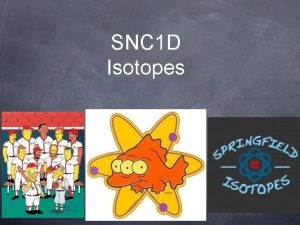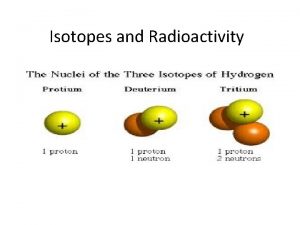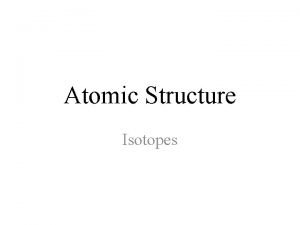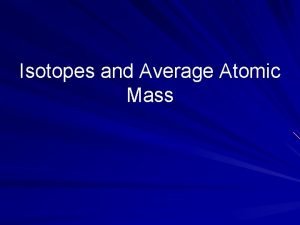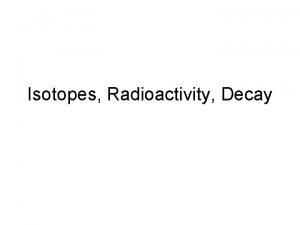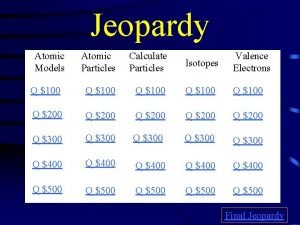Atomic Structure Review Isotopes Atomic Structure n The














- Slides: 14

Atomic Structure Review Isotopes

Atomic Structure n The central region of each atom is called the……… Nucleus 2

Atomic Structure The nucleus is made up of: n Protons which are positively charged e. g Li atom n o o+ o+ +o Nucleus (dense and positively charged) Neutrons which have no charge 3

Atomic Structure e- e- Electron shells nucleus e- n electrons electron Tiny negatively charged particles called electrons occupy the energy levels of an 4 atom

Comparative size of particles Subatomic particle nucleons Proton (p) Mass relative to a proton 1 Neutron (n) 1 Electron (e) 1/1836 Protons and neutron are relatively equal mass and are huge in comparison to electrons. Proton and neutron contribute nearly all the mass of the atom 5

Isotopes n n n Atoms of an element all have the same number of protons in their nucleus But they can vary in their number of neutrons thus giving them a different mass number to each other Such variants of an element are called ISOTOPES The isotopes of an element have different physical properties e. g some may be radioactive However, because they all have the same number of electrons, their chemical properties are identical. 6

Isotopes vital statistics n n n Atomic number: The number of protons in the nucleus of the atom Z Mass number: The total number of protons plus neutrons found in the nucleus A An Isotope of element X can be represented as: Mass number Atomic number X 7

Playing with numbers Mass number =p+n (Total nucleons) Atomic number Total no. protons A Z X Symbol of element So A=Z + neutrons or mass no. = no. of protons + no. of neutron AND Neutron=A-Z or neutrons=mass no. – protons/atomic no. 8

Symbol for the most common isotope of Li Li Mass number 7 Atomic number 3 Lithium mass no= 7 atomic number= 3 Neutrons=4 (7 -3= 4) 9

F 19 9 Ca 40 20 Fluorine Mass no: 19 p: 9 n: (19 -9) 10 e: 9 Atomic no: 9 Calcium Mass no: 40 Atomic no: 20 p: 20 n: 20 e: 20

Isotopes of Hydrogen n n Nuclei of the three isotopes of hydrogen Protium Deuterium Tritium H 1 1 H 1 2 H 1 3 Complete the table for isotopes of hydrogen 11

Isotopes of Hydrogen Check your table Isotope Atomic Mass Number No. of protons electrons neutrons protium 1 1 0 deuterium 1 2 1 1 1 tritium 1 3 1 1 2 J. Lowman : Atoms Refresher 12

Isotopes of Carbon C 6 12 C 6 13 C 6 14 Complete the table for isotopes of Carbon 13

Carbon Isotope Check your table Isotope Atomic Number Mass Number No. of protons electrons neutrons Carbon 12 6 6 6 Carbon 13 Carbon 14 6 13 6 6 7 6 14 6 6 8 14
 Atomic isotopes
Atomic isotopes What is
What is Fertile isotopes
Fertile isotopes How to calculate average mass percent
How to calculate average mass percent Isotope abundance formula
Isotope abundance formula Applications of radioisotopes
Applications of radioisotopes Rubidium has two common isotopes 85rb 87rb of abundance
Rubidium has two common isotopes 85rb 87rb of abundance Beta minus decay
Beta minus decay Write the hyphen notation of the three isotopes of hydrogen
Write the hyphen notation of the three isotopes of hydrogen Isotopes pogil
Isotopes pogil Mass number of chlorine
Mass number of chlorine Lesson 13 subatomic heavyweights isotopes
Lesson 13 subatomic heavyweights isotopes Isotopes
Isotopes Isotopes meaning
Isotopes meaning Oxoacids of nitrogen
Oxoacids of nitrogen

